“Christine” by 000fesbra000, CC License
Disclaimer: This post contains affiliate links that add gold to our coffers.
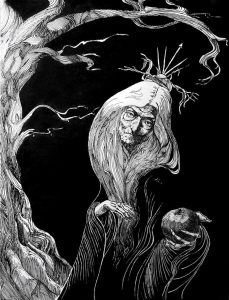
For as long as mankind has feared the unexplainable, the Witch has been a foreboding force in the imaginations of all. Traditionally, witches have taken the blame for enigmatic phenomenon, lustful beguilement, and heretical influence. Witches have also been utilized to beseech beings of other realms.
In the Bible, the Witch of Endor called upon the spirit of Samuel, who prophesied the death of Saul the following day. In 1486, “The Hammer of Witches” guided German men on how to identify and hunt witches. In 1706 Virginia, Grace Sherwood was convicted of killing her neighbors’ pigs and hexing their cotton, thrown into a lake, and accused of witchcraft for not sinking (Source).
In this article, we’ll explore several classifications of witches, including druidic Wiccans, prophesying Seers, traditional Hags, sea-faring Sirens, and astrological Cosmic Witches. We will also provide several canonical class builds, following the rules-as-written Dungeons and Dragons manuals.
Note: Though we often refer to witches as female throughout this article, there is precedence for male witches (historically referred to as warlocks). Please use this guide to fit whatever needs you have as a player.
The Wiccan
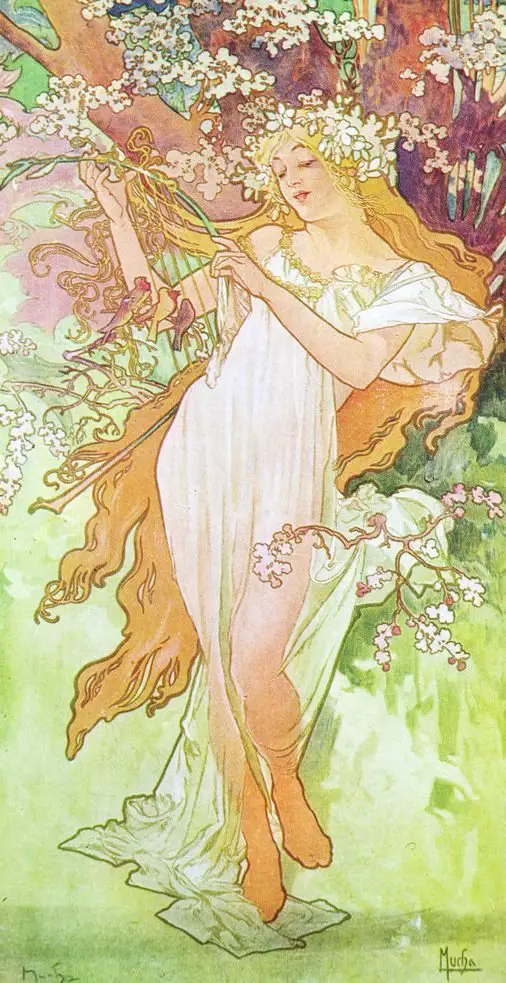
Worshippers of nature, Wiccans fare on the gentler side of witchcraft. Expect your Wiccan character to be aligned good, though perhaps chaotic, as her beliefs may not be accepted in certain villages. Wicca covens are typically small, tight-knit, run by wise priestesses, and hold the credo “An it harm none, do what ye will.”
Wicca is typified by its worship of a female deity, The Goddess, and other associated gods. Sisters in style to Shamans, Wiccans believe in meditation and seasonal rituals revolving around moon cycles, planet obits, the vernal equinox, summer solstice, and Halloween by invoking deities, crafting potions, cleansing energies, and casting spells.
Your Wiccan character should explore skills in Herbalism, brewing potions in the form of teas. See our guide to crafting magic items, which applies to potions. Furthermore, you should speak to your DM about developing formulas for your potions.
Elements of Wicca to Add to Your Character Description

- Use gemstones and crystals as your arcane focus, should you need one.
- Describe your spells in terms of Sacred Geometry if they require somatic components.
- Emphasize rituals occurring during moon cycles.
- Utilize herbs, especially for burning, to cleanse negative energies.
- Choose a deck of Tarot cards for your game equipment.
- Bring the four elements of nature into your character build.
- Choose a faithful familiar companion such as a cat or a raven to be by your side.
Class Builds
Druid: This nature-centric class is perfect for a Wiccan witch build. Choose Circle of the Moon (Player’s Handbook) for Wiccan lore adjacency: “Their order gathers under the full moon to share news and trade warnings.” Circle of the Land also fits coven fables: “mystics and sages who safeguard ancient knowledge and rites[,…] the circle’s wisest members preside as the chief priests of communities that hold to the Old Faith.”
Wizard: Arcane magic is your domain as a Wiccan Wizard. Choose the School of Theurgy (Unearthed Arcana) if your DM allows official playtest material. “…for magic is as much a part of the fabric of the cosmos as wind, fire, lightning, and all other primal forces.” For your chosen Cleric domain as part of this Wizard archetype, choose one that also focuses on Arcana, such as the Arcana Domain (Sword Coast Adventurer’s Guide), Nature Domain (Player’s Handbook), or Life Domain.
Cleric: A Wiccan can easily fit the build of a Cleric. Especially as one who has achieved some degree of priesthood in her coven, a Wiccan witch could fulfill the role of one of the “intermediaries between the mortal world and the distant planes of the gods.” Some appropriate domains would include Arcana Domain (Sword Coast Adventurer’s Guide), Nature Domain (Player’s Handbook), or Life Domain.
Magic
Choose spells that serve as wards (Absorb Elements, Guards and Wards), cleanse evil energy (Protection from Energy, Protection from Evil and Good), charge a space with magical energy (Guidance, Bless), call upon The Goddess (Augury, Divination), and improve health (Healing Word, Enhance Ability, Virtue).
Be creative in your justification of how your chosen spells work as a Wiccan. For instance, to cast the Locate Object spell: “I burn some sagebrush to clear my head. I hold a forked twig in one hand and my Citrine crystal (arcane focus) in the other, cross my arms in similitude of the pentagram Sacred Geometry, and call upon The Goddess to bring images to my mind where the Sword of Orion is.”
Battle
Your Wiccan character may not be comfortable with battle, but will realize that in order to protect what she loves, she must sometimes fight for it. Be satisfied as a support in battle, and shine in preparation for battle with potions, magic items, and wards.
The Seer
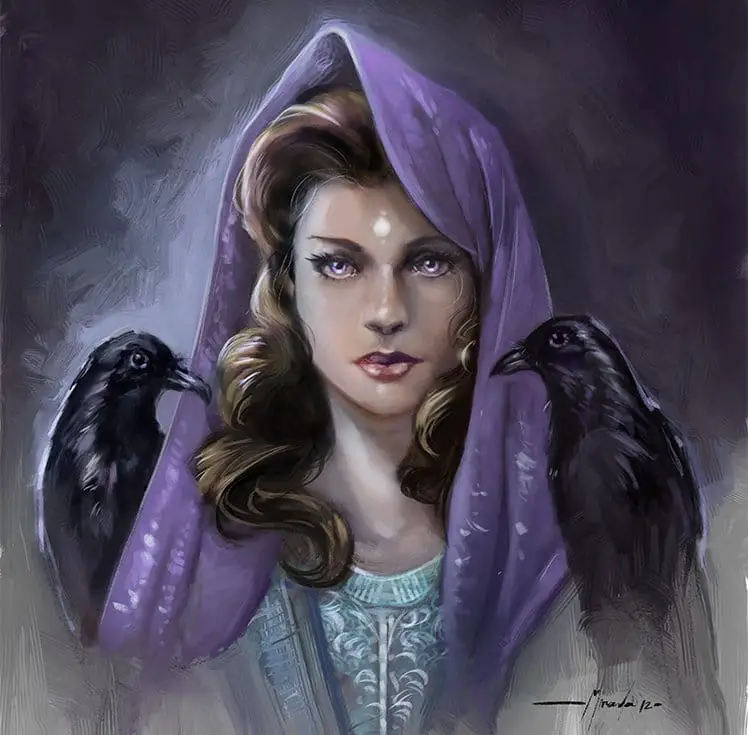
As prophets who connect to another world, the Seer witch focuses on divination, much like the Oracle build in our Necromancer Guide. Seers gain hidden knowledge through their own intuition, call upon a higher power for guidance, and use symbols, objects, and Sacred Geometry to communicate with spirits.
There are two paths The Seer witch could take: allowing gods to direct and depict the future, and puppeteering the future like a god. A good visual for these extremes would be a stereotyped Gypsy with a crystal ball versus the Weird Sisters in Macbeth, respectively.
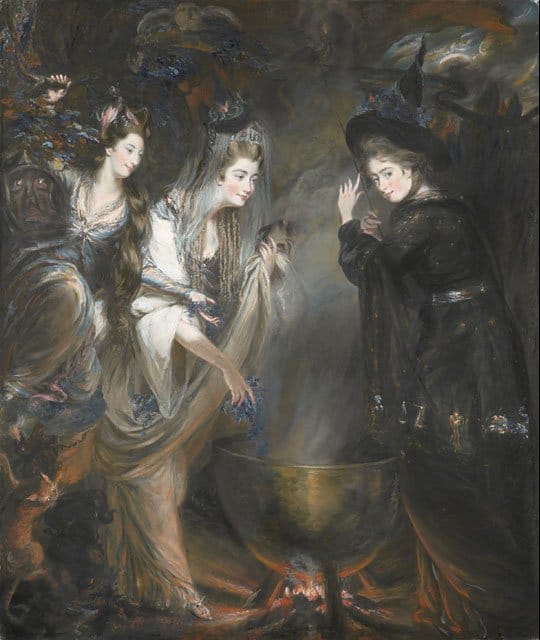
Like the Oracle, a benevolent Gypsy-styled seer would simply call upon higher powers to give direction. She would be helpful in advising the party with supernatural guidance, imperative in learning past events through seances, and knowledgeable in all things occult and metaphysical.
Contrast that with the shrewdness of Macbeth’s witches. “The mischief they cause[…] is the result of their understanding of the weaknesses of their specific interlocutors—they play upon Macbeth’s ambition like puppeteers” (SparkNotes). A Seer who wishes to be an agent of fate would recklessly call upon the dead to know how best to manipulate current events to achieve a desired outcome.
Elements of the Seer to Add to Your Character Description
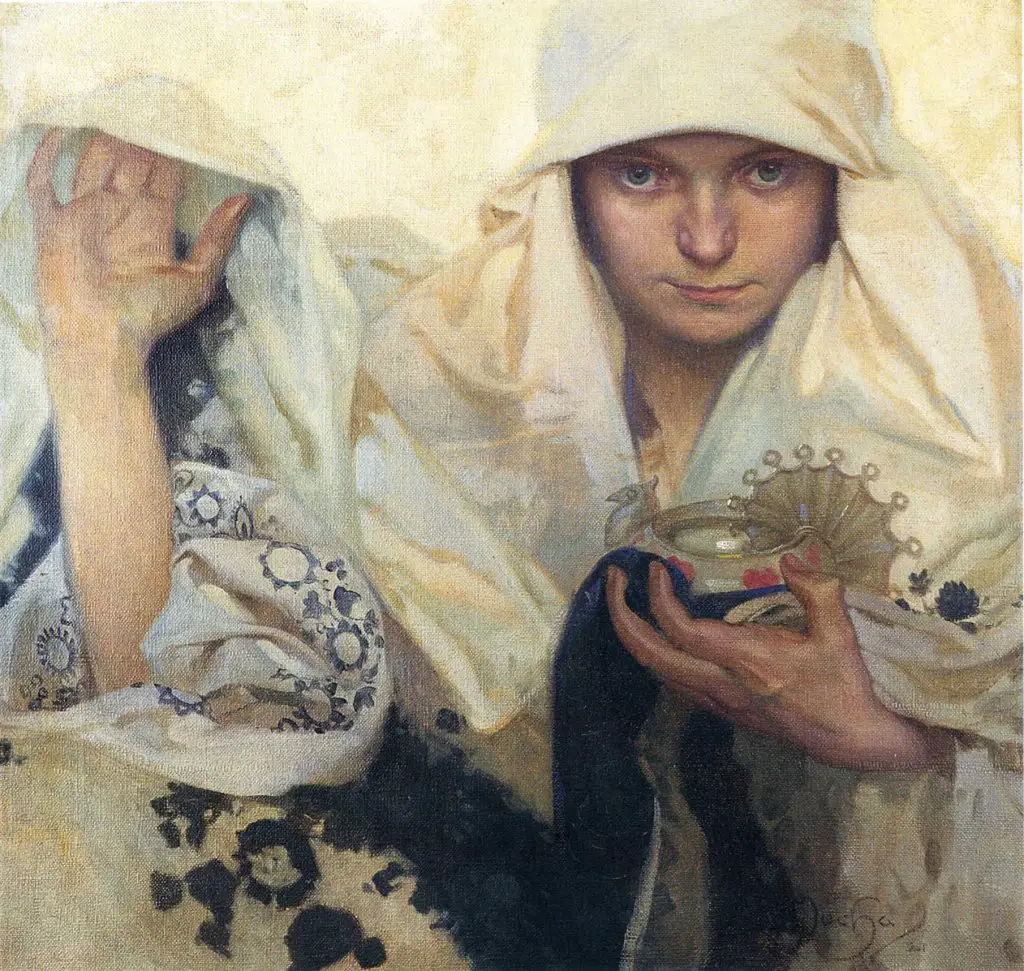
- Use runes, scrying glasses, crystal balls, Tarot cards, and deep meditation to communicate with higher powers.
- Determine if you have a coven and how that coven operates: traveling nomads, secluded crones, etc. This can help provide character elements for your Dungeon Master, including a possible Rival.
Class Builds
Wizard: The School of Divination perfectly describes this build: “As a diviner, you strive to part the veils of space, time, and consciousness so that you can see clearly. You work to master spells of discernment, remote viewing, supernatural knowledge, and foresight.” Plus, you’ll halve the gold and time required to add Divination spells to your spellbook and regain spells lots when using Divination spells.
Bard: As a diviner, you may have to add a splash of performance when foretelling events. Charisma will be useful in this endeavor. If you wish to manipulate others for your own benefit, the College of Whispers may be worthwhile. If you pursue magical secrets, the College of Lore is excellent for this build.
Sorcerer: Cosmic forces and a magical birthright combine to provide an excellent Seer Witch class. The Divine Soul (Xanathar’s Guide to Everything) archetype lends way to a character in close connection with deities. “Sometimes the spark of magic that fuels a sorcerer comes from a divine source that glimmers within the soul.” With Favored by the Gods, a Seer can change the outcome of a failed saving throw or attack. She can call upon the divine to provide extra healing.
With Metamagic such as Heightened Spell, your witch can foresee a saving throw being passed and use her wily magic to cause it to fail. With Empowered Spell, you can tell your spell isn’t going to be as powerful as you would like and change the outcome to do more damage.
Warlock: To mirror Macbeth’s witches, a Warlock is the way to go. The Great Old One (Player’s Handbook) provides you with eerie knowledge. By detecting thoughts, you can determine how to play on the weaknesses of others and manipulate their actions. With Entropic Ward, you can foretell an upcoming attack will hit, and sprinkle in your magic to cause it to fail. Your foreboding words can continuously echo in a person’s head with Create Thrall.
Magic
Focus on spells that foretell future events, change the outcome of attacks or saving throws, allow you to speak to otherworldly beings, and enchant others to do your bidding.
Battle
The Seer should help prevent oncoming attacks and ensure her attacks, and those of her allies, land. The Seer may also call on spirits in battle to do her deeds. She is most effective outside of battle, or in preparation for battle.
The Hag
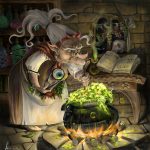
As a more traditional Halloween-style witch, this Hag build will focus on witchy stereotypes. The Hag utilizes flagrant enchantment, metamorphic potions, nefarious hexes, and faithful familiars. A few great examples of this build include the Queen in Snow White, the Sanderson Sisters, or Professor McGonagall (for a less malicious case).
“Swamp Witch” by Lenika86, CC License
Elements of The Hag to Add to Your Character Description
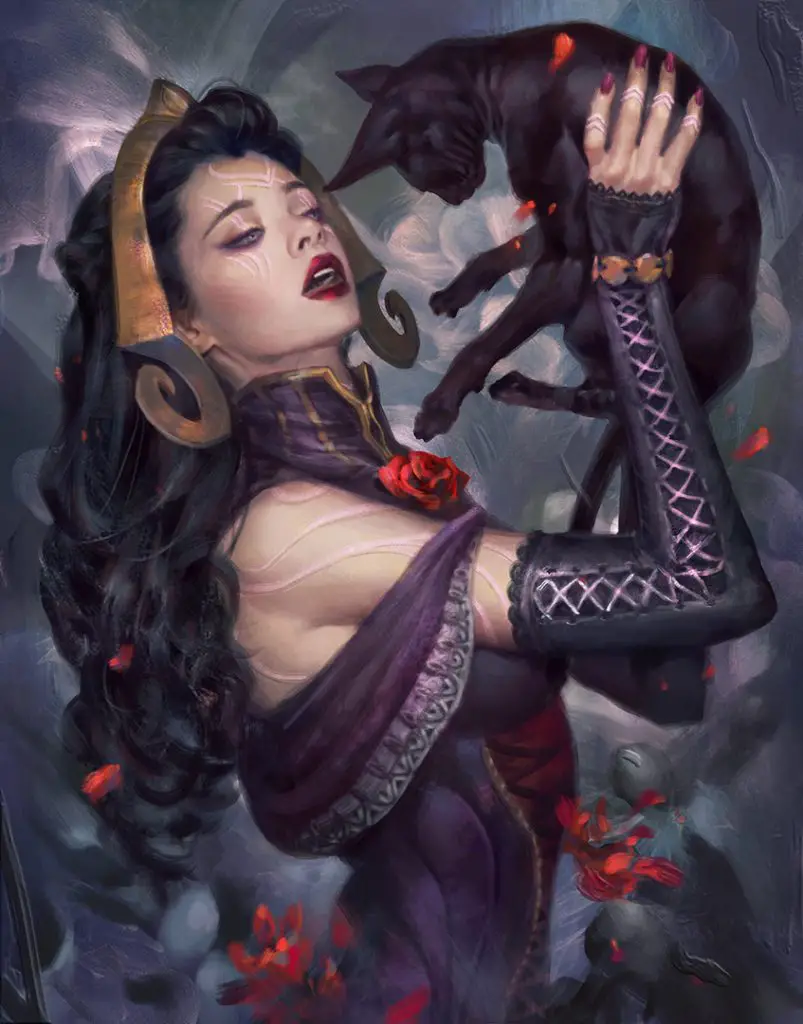
- Find a way to include a Familiar, such as a cat, bat, owl, etc.
- Embed the Polymorph spell into potions so that you can easily turn someone into a toad. See our Crafting Magic Items article for more information, and remember that consumables require half the time and cost!
- Create a magic broom for flying with ease.
- Develop a coven as part of your backstory. Think about why you left your coven to adventure. What resources are available to you as a result of being a part of a coven?
- Your spellbook (if you require one) should be spooky and unique.
Class Builds
Artificer: Explore D&D’s newest class The Artificer through a witch filter by enchanting mundane objects, conjuring a myriad of magical items, creating a Homunculus Servant, and becoming adept at potion-creation.
Warlock: Between cutthroat curses and spooky patrons, the Warlock class is an excellent choice for a traditional Hag. Invocations add an additional mark of macabre, with creepy abilities such as altering your appearance at will, extending your sight (even through walls), and soul-trapping. The Raven Queen (Mordenkainen’s Tome of Foes) is a meritable patron for this build, as is The Fiend or the Great Old One (Player’s Handbook).
Strike your enemies with ire using Eldritch Blast and all of its associated invocations.
Wizard: Most wizardry schools will work with the Hag build, but Enchantment, Evocation, Transmutation, Conjuration, Illusion, and Necromancy specifically fit the bill. Our recommendation is to look at school-specific spells to decide the direction your Hag will take. Recall that spell costs and time will be halved for the associated school you choose.
- Enchantment: With spells like Charm Person, Confusion, Modify Memory, and Zone of Truth, the Enchantment school beautifully bewitches foes. There is also great power in Enchantment with Mass Suggestion and Power Word Kill.
- Evocation: The School of Evocation is perfect for a Hag who hopes to strike hard. With spells like Chain Lightning, Darkness, Eldritch Blast, Fireball, Witch Bolt, Meteor Swarm, Scorching Ray, and Wall of Force, you are sure to horrify your enemies while hitting them where it hurts.
- Transmutation: This may be the most witch-like school. Alter Self: turn into a beautiful maiden or a ghastly crone; Control Weather: conjure storms to match your indignation; Fly: soar across the skies on your broom; Polymorph: turn the evil prince into a frog to teach him a lesson; Time Stop: time your spells perfectly by stopping time and casting another spell.
- Conjuration: Conjuration seems to be one of the more spooky schools: Black Tentacles, Call Lightning, Cloudkill, Demiplane. Other spells fit this witch build, like Conjure Animals, Find Familiar, Teleportation Circle, and Wish.
- Illusion: Spells like Dream, Greater Invisibility, Hypnotic Pattern, Mirror Image, Mislead, Silence, and Simulacrum seem pretty witchy, especially when a Wizard reaches level 14 and can make a portion of her illusions real for one minute with Illusory Reality.
- Necromancy: Exert the perfect hex with Bestow Curse, Blight, Eyebite, or Harm. Or opt for the ominous with Magic Jar.
Druid: With transformative abilities and a varied list of spells, the Circle of the Moon is an excellent candidate for your Hag-build witch. Turn into a cat, owl, bat or any other spooky animal with ease. See our Beast Shape spreadsheet for an easy reference of animal stats.
These Druid spells are among some that cast a witchy shadow: Charm Person, Fog Cloud, Speak with Animals, Call Lightning, Blight, Hallucinatory Terrain, Polymorph, Wall of Fire, Scrying, Conjure Fey, Fire Storm, Mirage Arcane, Reverse Gravity, Control Weather, Storm of Vengeance.
Magic
Hexes that hurl energy, controlling the weather, treacherous illusions, polymorphing adversaries into toads—anything goes with the Hag.
Battle
The Hag is probably the most volatile in battle out of these Witch archetypes. Depending on your class build, you could be a formidable foe or a wily rival.
The Siren (Sea Witch)
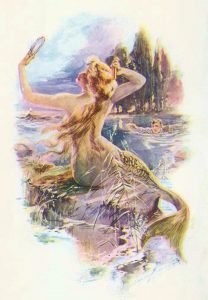
As a witch of the sea with the elements in her control, the Siren was born of ancient folklore and focuses on her ties to water. Often portrayed as a mermaid appearing to sailors, a Siren would fit into any campaign involving sea travel, or opt for a water-based backstory and her quest to return.
Calypso lures Odysseus to her island; Ursula beguiles Ariel to give up her voice; In The Tempest, Sycorax had domain over an island and powers over the moon. Sea Witches may worship deities such as Poseidon, Aphrodite, and Yemaya while working with sea monsters such as the Kraken or Leviathan.
Many Sirens are associated with seduction, but Sea Witches are also associated with healing. Water is a symbol of good health and cleansing, and thus water witchcraft may be an agent of welfare and blessing.
Elements of the Siren to Add to Your Character Description
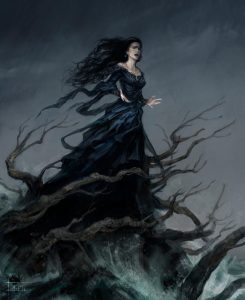
- In many tales, a Sea Witch would sell or give sailors a rope tied in three slipknots: the first knot could yield a gentle southeasterly wind when undone, the second a strong northerly wind, but the third knot would unleash a wrathful hurricane.
- Lure sailors with your beauty and voice. This could either help or harm them, depending on your intentions.
- Sirens are not required to live near the sea. Other bodies of water may draw them in: lakes, rivers, holy wells, reservoirs.
- Water Genasi may be ideal for your build, or you could explore the merfolk race.
- For more guidance on playing underwater, including additional races and classes, treasure and monster examples, sea-specific armor and weapons, and more, check out our Sea Exploration Adventure Guide.
Class Builds
Warlock: The Kraken as a patron is ideal for the Sea Witch. Gain access to spells influencing the weather and involving water, and employ skills like breathing underwater and unleashing the Kraken.
Druid: Like a Sea Witch, the Circle of the Land Druid regains magical energy by communing with nature. The focus of Coast fits the bill on this build, with access to water-controlling spells.
Bard: To fit the style of utilizing music as your weapon, the Bard is your class. College of Lore allows you to pick two spells from any class, which you can use to further your Siren stereotypes by choosing water- or weather-specific spells.
Sorcerer: A Sorcerer’s power may originate from her exotic bloodline. In 2017, Wizards of the Coast released a new Sorcerous Origin in Unearthed Arcana: Sea Sorcery. With this class, you can breathe and swim underwater with ease, infuse your spells with a watery curse, and defend yourself in a water form.
Magic
Focus on enchantment spells that charm people and magic that controls the elements.
Battle
Your Sea Witch will be very effective in battle, and she will surely be clever. Change the tide of battle with Fog Cloud; create a barrier with Wall of Water; force foes to reap the whirlwind with Maelstrom.
The Cosmic Witch

Searching for meaning in the cosmos, the Cosmic Witch focuses on astrology, astral projection, and celestial energy in her practice.
Similar to the Seer, the Cosmic Witch has influence with otherworldly beings, but in contrast, she physically ventures from the material realm to spiritual worlds—perhaps the flying broomstick stereotype is based on witches flying through boundaries and into other realms.
Elements of the Cosmic Witch to Add to Your Character Description
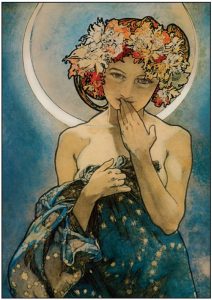
- Look for star charts and planetary cycles to influence your decisions and time your rituals.
- Check with your DM about which planets reside in their D&D universe. The goddess you worship may relate to these planets.
Alphonse Mucha’s Moon
Class Builds
Warlock: This is by far the most synergistic build for the Cosmic Witch. Unearthed Arcana from 2016 provides a new Warlock patron: The Seeker. “Your patron is an inscrutable being who travels the Astral Plane in search of knowledge and secrets.” With the addition of the Pact of the Star Chain, your Witch holds a “chain forged from starlight” that grants power and guidance from your patron. At level 6, your Witch can travel to the Astral Plane for refuge, and at level 14, can take companions for a short rest. Combined with other Warlock spells and invocations, this is the perfect class for a Cosmic Witch.
Cleric: A Cleric of the Arcana Domain (Sword Coast Adventurer’s Guide) believe that “magic is an energy that suffuses the multiverse.” With access to spells like Leomund’s Secret Chest and Teleportation Circle, and at level 17, by choosing spells like Demiplane, Astral Projection, Contact Other Plane, and Plane Shift, your Cosmic Witch is sure to flourish.
Wizard: Most spells relating to other planes of existence reside in the School of Conjuration. Your Conjuration Witch can create objects out of thin air, travel across existences, and summon creatures. Remember that with this school, Conjuration spells’ gold and time required are halved!
Druid: In this 2016 Unearthed Arcana, the Druid receives a new Twilight Circle. These Druids seek to “preserve the natural cycle of life and death that rules over the cosmos.” Creepily drain life from other creatures, speak with the dead with ease, and finally, at level 14, cast Etherealness without expending a spell slot. This class may have fewer inter-planar spells, but you can rely on spells like Conjure Minor Elementals, Scrying, and Plane Shift to fill your Cosmic needs.
Magic
Focus on spells that touch on other planes of existence. This can include conjuration, planar travel, speaking to gods, and more.
Battle
Your Cosmic Witch will be a refuge in the agony of battle: rid your allies of enemies by banishing your foes; create safe spaces for healing in intermediary planes; seek guidance from your god. Expect to be a support in battle, but know that your efforts are vital to the survival of your party.
Do you have a favorite witchy build? Send us a message (in the footer) and tell us all about it!

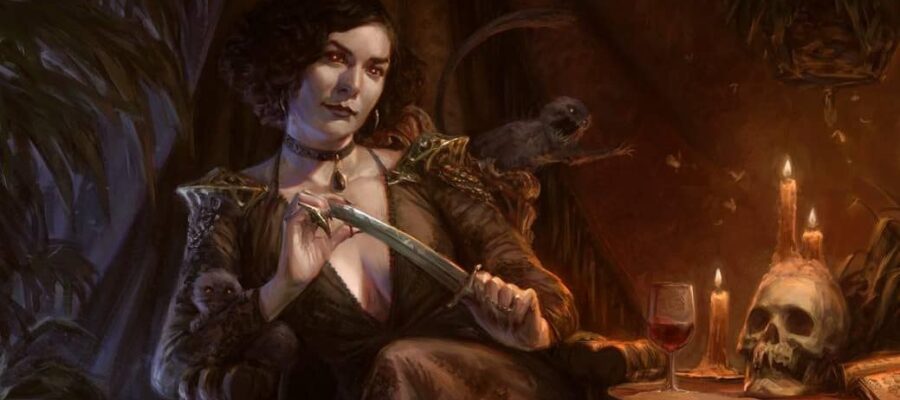



This helped me so much. I built a witch taking 5 levels in twilight cleric, a level in druid(I wanted primal savagery), and took the magic initiate feat: warlock for the hex spell an eldritch blast. My DM had us roll crazy high stats(which is probably the only way i could have blended CHA and WIS spellcasting). To say the least, my character rocks. thank you for this article.
I am so happy to hear it! It’s so satisfying to find niche RAW builds, even if they’re not always maximized. But in your case, kudos on the stats! Thanks for reading, and I hope your campaign is filled with ghoulish mischief and unparalleled heroism!
Here is a link to their character sheet…in case anyone would liked an example to used as inspiration. The campaign takes place around Ten Towns.
https://ddb.ac/characters/38737658/la5Bzq
This is amazing! I’ve always been attracted to witches and will use this to create one.
What about modern day witches like Sabrina?
I’m so glad you enjoyed it, Craig! For a Sabrina character, I would follow the “hag” type of build with hexes and potions. I would choose a Warlock Pact of the Tome for an arcane grimoire OR a Wizard School of Abjuration, Conjuration, Enchantment, Illusion, or Transmutation. It really depends which aspects of Sabrina you’re hoping to hit.
If you choose the Warlock and want to find a great patron, I wrote about the canonical lore of several of them here: https://www.flutesloot.com/warlock-patrons-lore/
Hope this helps! Thanks for reading, and bewitching adventuring!
Pingback: Which Class is the Witch Class? « Miniature Mage
Thank you for this information. As a complete novice this gives me a bit of footing.
Have you heard of Tiffany Aching from the Terry Pratchett trilogy? What might lead to her style of power?
Absolutely yes, it’s one of my favorite trilogies! Pratchett writes witches marvelously, as practical doers who think of magic differently from “spells.” I would say Tiffany may be a Druid, which would make a good Pratchett-witch in general, but one who doesn’t focus on animal transformation. This Druid build would be more in-tune with the natural world around them, who is willing to lend a hand and do the hard work required to help others. Magic manifests in connection with the absolute need for it, but what is magic if not touching the hearts of others, or ushering a soul on to death comfortably?
With Tiffany’s connection to the Feywild, and based on the things she has accomplished, I might say she’s a Druid: Circle of the Shepherd (I mean, she literally WAS a shepherd haha). But above all else, you absolutely MUST wear a witch’s hat 😉
Thanks a lot, I was looking exacly to do an gypsy tiefling seer, mosty as divination wizard, but in the future I am gonna try tomake a multiclass in curses expert, probably as a druid, but I am still lost in the multiclass, any sugestion?
Sure! What do you hope to get out of the multiclass to become a curses expert? Let me know what the goal is, and I can point you in a few directions.
Probably someting like a shaman or a witch covin.
I missed your response, sorry. Are you open to third-party content? That would take care of a lot of work for you. Otherwise, do picture your character as an expert on curses like lycanthropy or of spells that resemble curses?
I ended planing to use her in pathfinder, she will play as fortune teller background and a curse witch as class, and she’s cursed into a tiefling.
Right on! 🙂